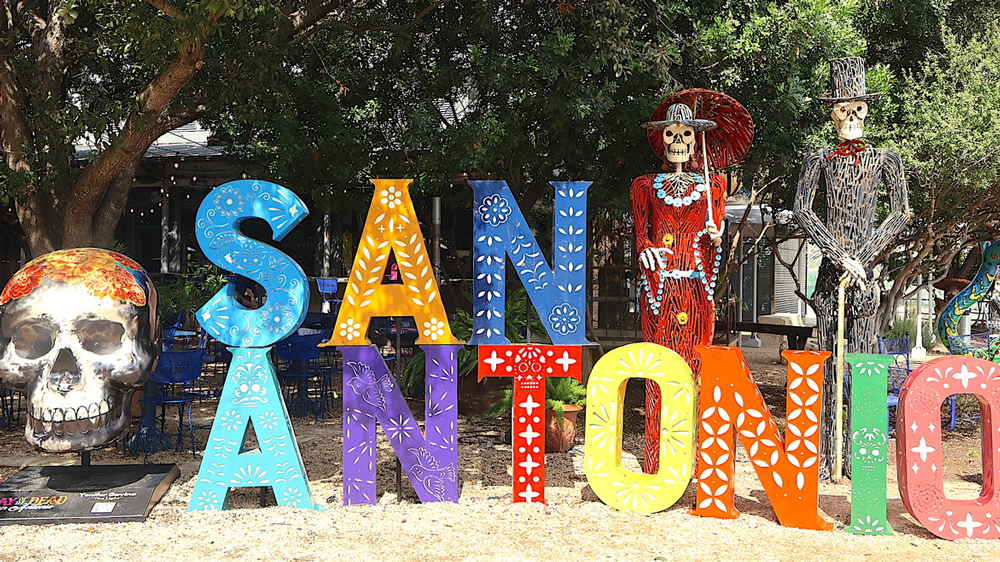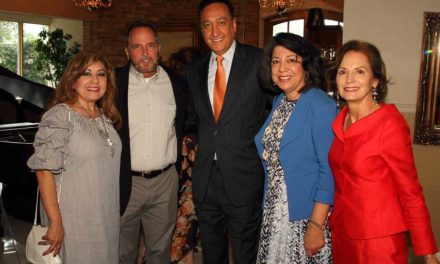Dia de los Muertos or Day of the Dead is celebrated on November 1st and 2nd by Mexicans wherever they live. It is one of Mexico’s most colorful holidays and an important day of festivity in U.S. communities with large Mexican-American residents. The celebration is based on the belief that during these two days, “the souls of the dead awaken and return to the living world to feast, drink, dance, and play music with their loved ones” [History.Com Editors].
Dia de los Muertos has been celebrated in Mexico for centuries although Mexican scholars are divided on the question of when this tradition started. Some historians
date the celebration to the Olmecs and Aztecs. Several pre-Colombian scholars credit the 14th-century Aztec Queen Mictecacihuatl, a ruler of the underworld, as the initial protector of the dead. The Aztecs believed that Mictecacihuatl returned annually to grave sites during the corn harvest period to make certain that the bones of the deceased were protected.
The Aztec Queen’s visit was celebrated with ofrendas [offerings], dances, and the preparation of special foods such as pan de muerto or atole [corn cereal]. On those celebratory days, the dead were thought to be awakened from their eternal sleep by the presence of family and friends, the scent of food, and the coveted smell of marigold flowers. Music and candles also contribute to the awakening.
Aztec art and artifacts suggest that Nahualt-speaking ancestors may have practiced celebrations of the dead in the centuries before they migrated to the interior of Mexico where they founded the Aztec capital. The Spanish conquistadors who arrived in the Aztec capital in 1519 found evidence of art and sculptures demonstrating that the Aztecs believed in the underworld and honored ancestral gods who ruled in that world.
Some Mexican historians question the Aztec origin of Dia de los Muertos and argue that the Spaniards introduced their Catholic observance of All Saints and All
Souls Day to Mexico in the aftermath of the conquest of the Aztecs in 1521. These two Catholic holidays are traditionally celebrated on the first two days of November. Mexican historian Elsa Malvido, founder of the institute’s Taller de Estudios sobre la Muerte, completely discards an Indigenous origin arguing that the tradition can be fully traced to Medieval Europe [5th to 15th centuries] and Spain. Malvido notes that in the centuries before the conquest of Mexico, Catholics in Southern Europe constructed altars for the dead and placed offerings of sweets in the shape of skulls and bread in the shape of bones on their altars.
When it comes to an annual traditional observance that includes food, drink, music, and dressing up like skeletons, the origins debate seems to matter very little. My wife and I attended one very joyful Dia de los Muertos celebration some years ago in Oaxaca, Mexico where we followed the processions and visited several large cemeteries at midnight. The cemetery reunion is special. Families gather at the gravesite, usually with elaborate marigold flower decorations and the favorite drinks and foods of those they honor. Most families sat around the gravesite visiting, singing, and eating. Friends passed by to greet the family members and offer memories of the dead. Candles were lit, and drinks such as tequila, pulque, and beer were carefully placed around or on top of the graves of deceased adults. Drawings, favorite toys, papel picado, and photos decorated the gravesites of children and adolescents. Many chose to share their drinks with the expected spiritual visitors. Pan dulce, other treats, and favorite dishes were also included.
Today’s broad public celebrations of this event have relatively recent origins in the United States. For 250 years, the Day of the Dead celebrations in
Spanish/Mexican Borderland communities were private and modest. Even one hundred years ago, the Day of the
Dead was a private affair, usually celebrated by faithful families wishing to remember their loved ones. Although the celebration has ancient roots, the cultural tradition is celebrated enthusiastically today by thousands in cities with large Latino populations.
U.S. Latinos’ first introduction to Dia de Los Muertos occurred in the early 1970s as they began to cultivate an interest in Mexican and Chicano art. Mexican art, which gained popularity in the U.S. in the 1970s, provided Latinos with the ideal visual interpretation of what the Day of the Dead meant to the Aztec people. The great Mexican illustrator and lithographer Guadalupe Posada [1852-1913] is credited with the popularization of imagery once employed by the Aztecs to convey deceased persons. His drawings of calacas and calaveras [skeltons and skulls ] were popularized in the penny press and later incorporated into murals by the acclaimed Mexican painter Diego Rivera.
This year UNAM students in Mexico City competed for the opportunity to come to San Antonio’s UNAM to construct an altar in honor of famed Mexican artist Juan
O’Gorman. Three architectural students won the competition and spent a week in San Antonio [October 23-30] carefully constructing an elaborate altar for Juan O’Gorman who is known in San Antonio for completing the mosaic tile mural on the Convention Center. On October 26, the UNAM inaugurated the altar, a splendid artistic creation with a stunning floor painting constructed with colored rice. The Mexican students were also invited to build an altar at the San Antonio Museum of Art.
This fall, Centro Cultural Aztlan invited students from St. Anthony’s High School to construct a Day of the Dead altar on the gallery’s exhibit floor. The Centro’s exhibition of altars included San Antonio artist Hector Garza whose elaborate altar honored his grandparents. Students at Mark Twain, a San Antonio Bilingual Junior School, under the direction of art teacher Ms. Elizabeth Diaz, constructed an altar dedicated to artist Jesse Trevino.
Day of the Dead altars are found across the city of San Antonio and my wife and I were not surprised to see them at The Pearl and Esperanza Center. Large altars take time to build and most are placed inside to protect them from
bad weather or careless admirers. The popular La Gloria and Rosario’s restaurants placed attractive large calaveras and calacas in their outside spaces. Mi Tierra Mexican Restaurant in Market Square has constructed altars for many years and it is always a sure bet to see a beautiful one there.
As social media introduced this Indigenous
celebration to global audiences, more U.S. cities with large Latino populations have added Day of the Dead celebrations to their annual cultural events calendars. Local community groups incorporate adaptations of this cultural legacy to reflect links to Indigenous roots as well as contemporary experiences. The regeneration of this Day of the Dead celebration has brought growing attention to the deep and rich heritage of Latino culture in the
United States. The event offers an opportunity to celebrate our loved ones and bring family and community together.
In 2008, UNESCO recognized the importance of Dia de los Muertos by adding the holiday to its list of Intangible Cultural Heritage of Humanity. Today the world knows more about this holiday because of the immensely successful Disney movie Coco.
Celebrating Day of the Dead in San Antonio, Texas










